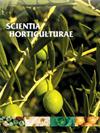热诱导 HpbHLH43 通过激活 HpSOC1 参与促进番木瓜花芽诱导过程
IF 3.9
2区 农林科学
Q1 HORTICULTURE
引用次数: 0
摘要
番木瓜属于仙人掌科番木瓜属,因其对干旱和高温胁迫的耐受性强,在热带和亚热带地区的栽培越来越多。从无性期到生殖期的过渡对果实产量有很大影响,因此揭示番木瓜的开花调控机制至关重要。本研究发现了一个与胁迫耐受性和开花诱导有关的 HpbHLH43 转录因子。为了进一步研究 HpbHLH43 的生物学功能,研究人员从番木瓜中获得了一个 747 bp 的全长编码序列(CDS)。在高温胁迫(42 °C)下,HpbHLH43在番木瓜茎和花芽中的表达上调。瞬时表达表明,HpbHLH43 位于细胞核中,其 N 端具有转录活性。生物学上,热诱导 HpbHLH43 启动子激活叶片和花中的 GUS 基因表达。在拟南芥中过表达 HpbHLH43 能显著加快开花时间,并且比野生型更耐高温。酵母单杂交和双荧光素酶试验表明,HpbHLH43能与HpSOC1相互作用。最终,高温诱导的HpbHLH43直接靶向HpSOC1,从而促进了番木瓜花芽的诱导,为番木瓜花诱导的分子调控提供了深入的见解。本文章由计算机程序翻译,如有差异,请以英文原文为准。
Heat-induced HpbHLH43 involves in promoting floral bud induction via activating HpSOC1 in pitaya
Pitaya, belonging to the genus Hylocereus of Cactaceae family, is increasingly cultivated in tropical and subtropical regions due to its high tolerance to drought and heat stresses. The transition from the vegetative to reproductive stage significantly impacts the fruit yield, therefore it is essential to unravel the flowering regulatory mechanism of pitaya. In present work, a HpbHLH43 transcription factor was identified, which is related to stress tolerance and flowering induction. To further investigate the biological function of HpbHLH43 , a 747 bp full length coding sequence (CDS) was obtained from pitaya. Under high-temperature stress (42 °C), the expression of HpbHLH43 were up-regulated in stem and floral buds of pitaya. Transient expression showed that HpbHLH43 was located in the nucleus and had transcriptional activity at the N-terminal. Biologically, heat induced the HpbHLH43 promoter to activate GUS gene expression in leaves and flowers. Overexpression of HpbHLH43 in Arabidopsis thaliana significantly accelerated flowering time and was more tolerant to high temperature than the wild-type. Yeast one-hybrid and dual-luciferase assays showed that HpbHLH43 can interact with HpSOC1 . Conclusively, high-temperature inducible HpbHLH43 directly targets HpSOC1 , accordingly, promotes the floral bud induction in pitaya, which provides an insight into the molecular regulations of floral induction in pitaya.
求助全文
通过发布文献求助,成功后即可免费获取论文全文。
去求助
来源期刊

Scientia Horticulturae
农林科学-园艺
CiteScore
8.60
自引率
4.70%
发文量
796
审稿时长
47 days
期刊介绍:
Scientia Horticulturae is an international journal publishing research related to horticultural crops. Articles in the journal deal with open or protected production of vegetables, fruits, edible fungi and ornamentals under temperate, subtropical and tropical conditions. Papers in related areas (biochemistry, micropropagation, soil science, plant breeding, plant physiology, phytopathology, etc.) are considered, if they contain information of direct significance to horticulture. Papers on the technical aspects of horticulture (engineering, crop processing, storage, transport etc.) are accepted for publication only if they relate directly to the living product. In the case of plantation crops, those yielding a product that may be used fresh (e.g. tropical vegetables, citrus, bananas, and other fruits) will be considered, while those papers describing the processing of the product (e.g. rubber, tobacco, and quinine) will not. The scope of the journal includes all horticultural crops but does not include speciality crops such as, medicinal crops or forestry crops, such as bamboo. Basic molecular studies without any direct application in horticulture will not be considered for this journal.
 求助内容:
求助内容: 应助结果提醒方式:
应助结果提醒方式:


